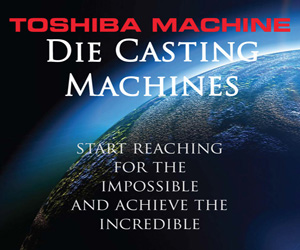This section presents an introduction to die casting alloys for product designers, at a level that does not require metallurgical background. It enables the design engineer to better evaluate the available die casting alloys and select the optimum for a product application.
The following topics are discussed:
- Range of Mechanical and Physical Properties
- Aluminum Alloy Characteristics
- Magnesium Alloy Characteristics
- Zinc Alloy Characteristics
- ZA Alloy Characteristics
- Alloy Selection
- Supply of Aluminum, Magnesium and Zinc
Range of Properties
Four major alloy groups account for most of the die castings produced in North America: aluminum, magnesium, zinc and zinc aluminum (also known as ZA). These four groups offer the designer a wide range of material properties. For example:
- Material densities range from 0.066 lb/in3 (1.81 gm/cc3) for magnesium alloys to 0.24 lb/in3 (6.65 gm/cc3) for zinc alloys, a ratio of near four to one.
- Ultimate tensile strengths range from 31 ksi (210 MPa) for magnesium alloy AS41A to 60 ksi (414 MPa) for ZA-27, a ratio of approximately two to one.
- Modulus of elasticity varies from 6,500 psi (45 GPa) for magnesium alloys to 11,800 psi (81.3 GPa) for aluminum alloy 390, a ratio of almost two to one. (The modulus of elasticity of zinc alloys varies with stress level and time and is not usually represented by one number.)
Die casting alloys have several characteristics in common:
- They do not exhibit the sharp yield point characteristic of carbon steels; instead they yield gradually when stressed. Therefore, the term yield strength is used, and is defined as the stress at which the stress-strain curve deviates 0.2% from the modulus line (0.2% offset).
- They have low melting points relative to copper and ferrous alloys and may exhibit a tendency to creep under conditions of long-term continuously applied loads. Creep occurs particularly at elevated temperatures, where it does not occur with copper and ferrous alloys. The tendency varies with the alloy. A moderate amount of creep does not prohibit the use of a material, but does require special design measures.
Physical and mechanical properties of the most commonly used die casting alloys are given in the following table that may be opened as a .pdf by clicking on this link.








